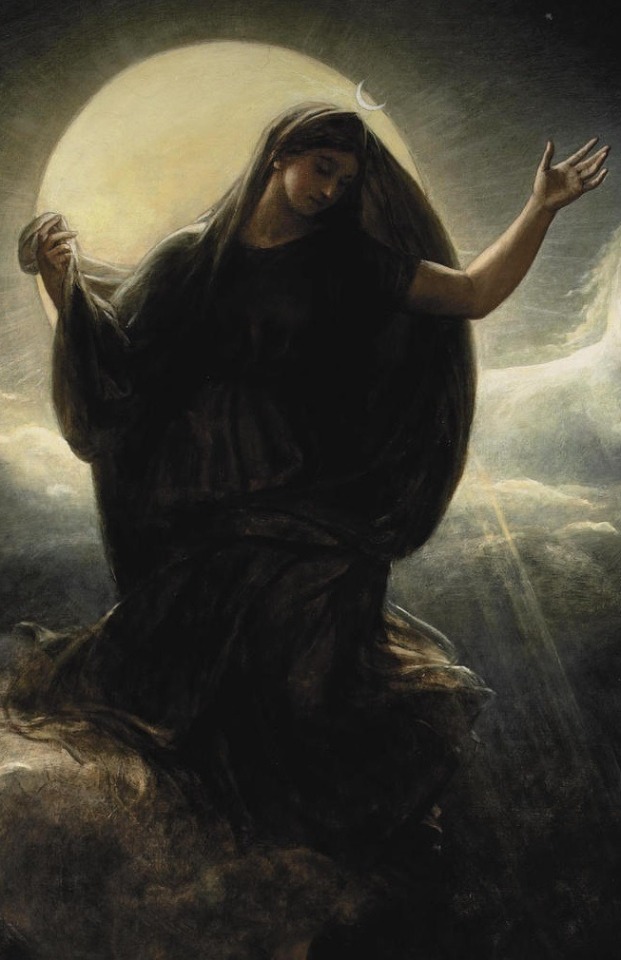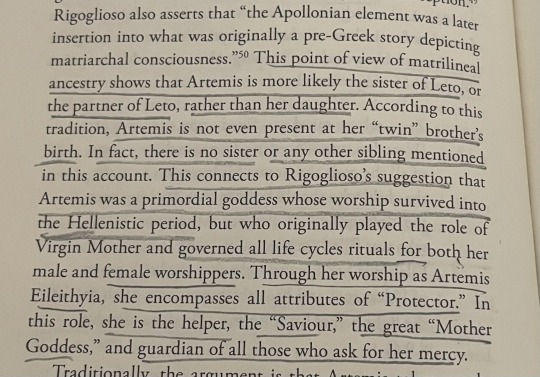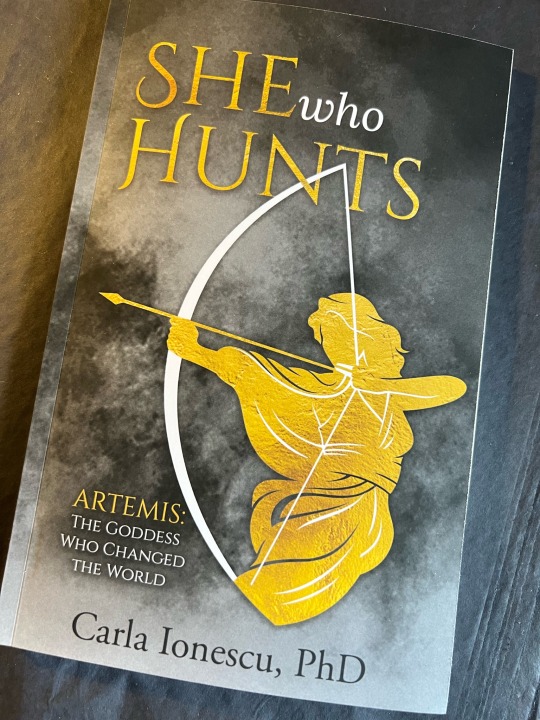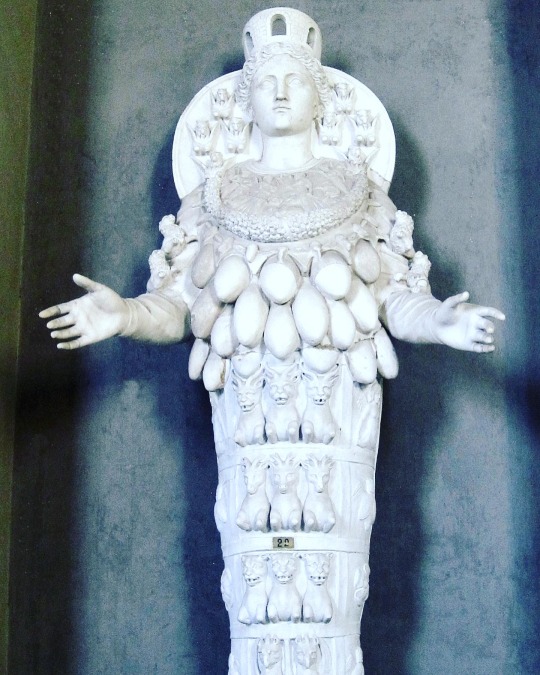#Carla Ionescu
Text
Artemis Phosphorus (Bringer of Light) ✨️

(Diana Awakening Apollo [1910] by Carl Bertling)
Callimachus refers to Artemis as “Queen” and asserts that when Artemis was a young girl sitting on her father Zeus’ knees, asking him to allow her to keep her maidenhood forever and receive her bow and arrows, she also asked him to be Phosphorus, or “Bringer of Light,” which became one of her many titles (Callimachus, Hymn 3.1). One of her most popular temples as “Bringer of Light” is at Messene in the sanctuary of Asclepius (Pausanias 4.31.10).
Zeus is more than delighted to give her all that she asks for: “three times ten cities and towers more than one live vouchsafe thee — three times ten cities that shall not note to glorify any other god but to glorify the only and be called of Artemis. And thou shall be Watcher over Streets and Harbors” (Callimachus, Hymn 3.28).
Thus, in addition to her being Phosphorus, she is also Enodia, “Protector of the Mariners.” Consequently, Artemis is not only “Saviour” through mercy — that is, people do not only pray to her for protection and peaceful death — but she is “Saviour” in a way that is omnipresent. As the “Bringer of Light,” her luminance literally saves ships, harbors, and all those who depend on these facilities to survive. In her role as Sôteira, Artemis inhabits the personal spaces of her community of worshipers.
As a goddess of mercy, she is invoked as Phôsphoros, meaning “Bringer of Light,” and she is often Hêmerasia or “She Who Soothes.” ... it is significant that her ritual worship expanded from “Huntress,” or goddess of wilderness, to the “Saviour” of her supplicants and the “Protector” of communities and cities.
- She Who Hunts: Artemis: The Goddess Who Changed the World by Carla Ionescu
#artemis#diana#Carla Ionescu#goddess artemis#artemis goddess#artemis devotion#artemis devotee#artemis deity#hellenic polytheism#hellenic pantheon#hellenic gods#hellenic community#hellenic pagan#hellenic paganism#hellenic polytheist#hellenic worship#goddess diana#diana goddess#diana deity
401 notes
·
View notes
Text

She Who Hunts Carla Ionescu
79 notes
·
View notes
Text
The evolution of the religion of Artemis extends at least as far back as predynastic Egypt, through Minoan and Mycenaean culture and onto into the Greek period. It is evident from this history that Artemis is the key figure through which goddess ritual, tradition, and community worship is preserved and adapted over time. By the Greek period, Artemis had become the most popular goddess of the Mediterranean. This popularity and devotion of her followers is evident not only in her numerous titles and incarnations but particularly in the moments in which she is called upon or adored.
—Dr Carla Ionescu, She Who Hunts: Artemis, the Goddess who Changed the World
65 notes
·
View notes
Text
Thanks for the tag @wildemaven!
Currently reading: Midnight - Dean Koontz, She Who Hunts - Carla Ionescu, The Devil in the White City - Erik Larson and a little bit of fic thrown in there too.
Last song: my mom had Marc Broussard on in the car on the way home tonight, but I don't remember the last song that was playing....
Last movie: I think it was Elvis?
Currently working on: nothing at the moment because I'm annoyed and aggravated and fed up and yeah, I just have a lot of issues 😂
NPTs @stillbeatingheart
7 notes
·
View notes
Text

I’ve been following along @artemisexpert on her treks in Crete to find hidden temples and since her book was on my buy list, I grabbed a copy to distract me from what I’m now calling The Tower of Dionysus. It looms. Carla Ionescu was one of my favorite discoveries of 2022 and her book is a delight. Plenty of source notes, well researched, written with obvious affection. Love the depth she gives Artemis. #witchstacks #greekmythology #artemis #diana #hellenism #goddesses
14 notes
·
View notes
Text
youtube
We’re hours away from the 4th of July and I figured there’s no better way to celebrate freedom than by sharing my most recent conversation discussing the wild and free goddess, #Artemis
Check out my jam-packed conversation with Artemis expert, Artemis Expert Dr. Carla Ionescu on this complex figure. Together with guest panelists Roz Carlos, MA and Dr. Courtney Kleftis we discuss:
Artemis’ ancient Neolithic roots
The ubiquity of the Goddess of the Hunt archetype across many cultures
Her role in girl’s puberty rites and why we need these rites today
Her mysterious role as torch-bearer and possible underworld goddess
The history and intrigue of one of her most important temples in Ancient Greece, the Artemis Sanctuary of Brauron.
Go to the link in my bio to find out conversation on YouTube! Once there, don’t forget to hit “like”, leave a comment, share with friends, and subscribe to my channel!
#divine feminine#Artemis#greek goddess#greek mythology#goddess of the hunt#sacred feminine#goddess#neolithic goddess#the historical Artemis#artemis temple#Youtube
2 notes
·
View notes
Text
Quanti studenti usano programmi di intelligenza artificiale per scrivere testi?
Quanti studenti usano programmi di intelligenza artificiale per scrivere testi?
AGI – La a storica rumena Carla Ionescu ha raccontato giorni fa di aver carpito una conversazione tra due suoi allievi che si scambiavano consigli su quale programma d’intelligenza artificiale funzionasse meglio per scrivere i loro testi. I programmi di IA sono già così diffusi tra gli studenti univesitari? Del tema si è occupato il quotidiano inglese The Guardian, che segnala anche alcune…
View On WordPress
0 notes
Text










Name: Charles Xavier/Professor X.
Loved Since: Forever.
Charles and I met at a bookstore when he was in my hometown on the first stop of his lecture tour (he was giving lectures on genetics and mutations). We were looking for the same book (The Complete Language of Flowers: A Definitive and Illustrated History by S. Theresa Dietz) and our hands touched as we both grabbed the same copy and we turned and saw each other, my dark green eyes locking with his cerulean blue eyes. It was love at first sight! Since there was no other copy available at the time, Charles and I agreed to jointly purchase the flower language book. We also separately purchased the other books we each had found that day (Charles got a copy of Persuasion by Jane Austen, A History of Courtship: 800 Years of Seduction by Tania O’Donnell, and The Rose Bride by Nancy Holder; I got The Complete Brambly Hedge by Jill Barklem, Artemis: Virgin Goddess of the Sun & Moon--A Comprehensive Guide to the Greek Goddess of the Hunt, Her Myths, Powers & Mysteries by Sorita d’Este, She Who Hunts: Artemis: The Goddess Who Changed the World by Carla Ionescu, PhD, and Frankenstein by Mary Shelley). Charles and I share The Complete Language of Flowers, writing our names on the inside front cover with a metallic silver Sharpie that Charles had in his satchel. We had lunch at a nearby café that day as well (Charles was a gentleman and paid for lunch)! During lunch, Charles asked me if I would like to go on the lecture tour with him to get to know me better and since the shindigs required a +1 to go and he hadn’t brought a friend with him; I happily agreed.
During the lecture tour, we discussed the topic of mutants (among a variety of other topics as well)! While we were relaxing in our hotel room, he confessed to me that he is a mutant with powerful telepathic abilities, which he demonstrated with my permission by lightly reading my mind; I then confessed to him that I am also a mutant with the ability to heal (especially through food that is either made myself or that I put my healing powers into), which I demonstrated by taking a slice of pumpkin bread (we had stopped to get a few things from a nearby grocery store) and put some of my golden sage colored healing power into it and gave it to Charles. He ate the pumpkin bread and his lower back felt better (Charles had explained his disability to me; my powers didn’t cure his disability, just healed the pain he was experiencing). I also have a secondary mutation of botanical manipulation, which I later demonstrated by reviving the dead plants in the flower pots by the hotel doors. And thus our relationship began! After the lecture tour, I moved into Xavier Mansion and live in the lady of the house’s room connected to Charles’ master bedroom. After getting to know the rest of the teaching staff and the students over the course of several months (I help Charles grade student papers, teach about cooking/baking, and proofread Charles’ research papers), Charles found a code name for me: Dolce (Italian; sweet)! I don’t go out on missions though, which is fine with me. Charles insists that I have a third mutation: my great warm hugs.
We have been close ever since, starting as friends for the longest time before confessing our mutual romantic feelings for each other one evening over dinner (Charles never pries into my thoughts without permission, unless I’m thinking too loudly, which is why he was not aware of my feelings for him until I told him) and then we began courting! After 4 years of courting, Charles proposed and I said yes! We married in the springtime near the gardens of Xavier Mansion in a beautiful nondenominational handfasting wedding ceremony surrounded by our family and friends! Afterwards, we had a garden party-style reception which was very relaxing and included some fun games to play! Charles looked so handsome in his cream floral paisley tuxedo! I looked beautiful in my modest floral wedding dress! We are so happy to finally be married! We keep our paisley patterned handfasting ribbon in a box inside a specially made hope chest at the foot of our bed, which also contains our wedding clothes and other sentimental items. Charles still loves to woo me even after we’ve been married for years!
Charles and I have many terms of endearment for each other! We both call each other love, darling, sweetheart, dearest, peony, dear, honey, sweetie, dear heart, beloved, T’hy’la, ashayam, inamorata (Italian; sweetheart), and precious to name only some (he especially prefers using Italian endearments). Charles’ other nicknames for me are Sagey, Sae, floral/petal/rosebud (due to my general love of botany), doll, starshine (due to my love of space/astronomy and love of the musical Hair), cutie/cutie pie/cute stuff, pumpkin/muffin (due to my mutation), his best girl, mama bear, and peach. My other nicknames for Charles are Chas, Cee, chai (his favorite type of tea), dreamboat, cutie/cutie pie, pumpkin, papa bear, ol’ blue eyes, my best guy/fella, and sunshine.
#fictoromantic#fictosexual#professor charles xavier#charles xavier#professor x#professor xavier#charles xavier is my husband#my beloved charles#my darling charles#selfshipping#selfship things#selfshipping community#f/o#fictional love#fictoromance#selfship#fictional husband#fictional beloved
13 notes
·
View notes
Photo

Mademoiselle Denisa @murmodels Creative Director: Valentina Ionescu @valentinaionescumur Foto: Dragos Burcea @dragosburcea Hair Style: Silvia Campeanu, Andreea ciurea @gettssalons Makeup Artist: Carla Francesca Boboc @iamcarla.makeup #MURgirls #Newshoot #beauty #editorial #modeling #fashion #makeup #different #style #mademoiselle
1 note
·
View note
Text
What is 'Charisteria'?
The Festival of Lady Artemis + Lord Ares

(Photo credit: BBC)
***tw: animal harm and animal sacrifice***
One of the more popular festivals to Artemis is the Charisteria (“thanksgiving”), which took place on the sixth day of Boedromion (September).
According to Herodotus, there was already a long-standing, ancient celebration on this day for the goddess Artemis (and her brother Apollo), however, at some later time, the festival was enlarged and became associated with the Battle of Marathon.
The Greeks honoured their victory over the Persians by celebrating the goddess who brought them victory...
...Miltiades, an Athenian warrior who is often credited with devising the tactics that defeated the Persians at the Battle of Marathon, is said to have been the first to offer sacrifice to Artemis on the day of her ancient feast. Pausanias tells us that, as part of this same festival, 500 goats were sacrificed to Artemis Agrotera and Ares Enyalios.
The goats were taken into the temple on Ilissos in a ceremonial procession and sacrificed collectively. It was said that each goat was meant to represent a fallen Persian soldier, but that so many Persians had died in the battle that doing so would have culled the entire goat population.
What makes this festival especially interesting is that the sacrifices were offered at a temple of Artemis and Ares, which is a unique collaboration by these two divinities and speaks widely to their elated position in battle worship and war.
- She Who Hunts: Artemis: The Goddess Who Changed the World by Carla Ionescu
#tw: animal harm#artemis#Carla Ionescu#artemis deity#goddess artemis#artemis goddess#artemis devotion#artemis devotee#diana#goddess diana#diana goddess#diana deity#hellenic polytheism#helpol#hellenic community#hellenic pagan#hellenic gods#hellenic pantheon#hellenic paganism#hellenic polytheist#hellenic worship#animal sacrifice#tw: animal sacrifice
124 notes
·
View notes
Text

She Who Hunts by Carla Ionescu
40 notes
·
View notes
Quote
Thus, we see that Artemis transformed the ancient world by unifying many disparate practices across many goddess cults in a wide variety of regions, and by providing comfort to millions as they experienced different stages of life: birth, adulthood, marriage, old age, and death. She was the goddess for all generations, for all cultures, and in many ways her worship allowed for spiritual connections through a deep and instinctive understanding of nature and its transformative experience. She was as ever-changing and adaptive as the seasons, and as a result, her worship survived all cultural conquests and varying ritual interpretations.
Dr Carla Ionescu, She Who Hunts: Artemis, The Goddess who Changed the World
38 notes
·
View notes
Text


Dionysus, in a Roman fresco from Pompeii, in what I can only describe as a Fruit of the Loom grape costume. Spending my quiet months researching for my @botanicaobscuraconference presentation on entheogens in Dionysian mystery cults in March, and I’m astonished at the number of artistic representations I’ve found, across the ancient world, of the god of wine. This one reminded me of the Artemis of Ephesus statue in the Vatican Museum, with all the boob things attached to her breast area. Interesting side note: I’ve always read that all those mammaries represented her in a mothering aspect, but I heard a theory recently that those Artemis boobs may not be boobs after all and may be beehives, and for me, pointing back to the Melissa (lemon balm) grown outside of her temples and that her priestesses were beekeepers. This is the thing that I love so much about mythology and folklore; it’s all so layered and it reminds me again and again that ancient people were complex thinkers with rich storytelling traditions. Anyway, that grape get-up is definitely wearing Dionysus and not the other way ‘round. If you love Greek mythology and especially Artemis, I wholeheartedly recommend Dr. Carla Ionescu’s @goddessprojectpodcast where she digs deep into Artemis. #fruitoftheloom #artemisofephesus #greekmythology #dionysus #hellenism
4 notes
·
View notes
Text
Teatrul Arte dell’Anima vă așteaptă la spectacolul „Lettice și Leușteanul” de Peter Shaffer, traducere de Crina Lință, regia Geanina Hergheligiu în data de 2 mai, orele 19:00 la Centrul European Cultural și de Tineret pentru UNESCO „Nicolae Bălcescu” din strada 11 iunie, nr. 41. O comedie verbală, ierbală, dar nu și letală cu Crina Lință, Ioana Pavelescu și Silviu Biriș.
„Lettice și Leușteanul” este o savuroasă comedie satirică care spune, într-un stil plin de umor fin și nuanțat, British, povestea întâlnirii dintre Lettice Douffet, ghid turistic la Conacul Fustian și Charlotte (Lotte) Schoen, aparent rigidul reprezentant al Consiliului Conservării și Protejării Obiectivelor Istorice ale Regatului Unit al Marii Britanii și al Irlandei de Nord. Lettice decide să urmeze „regula celor trei Δ, regulă moștenită de la mama ei, imaginând fapte grandioase petrecute pe Marea Scară a Conacului. Lotte o concediază, dar are revelația întâlnirii unui om „spectaculos”, pe care, săptămâni mai târziu, simte nevoia sa îl caute. Lotte îi va împărtăși acesteia faptul că a moștenit de la tatăl ei, „ochii” pentru frumos, pentru construcțiile cu arhitectură splendidă, care dau identitate. Cele două petrec tot mai mult timp împreună, reînviind scene din istorie și, inevitabil, se produce un accident, care conduce la un proces public. Cel mai intrigat de toate întâmplările ciudate care declanșează accidentul este avocatul Bardolph, un profesionist prins fără voia sa în mrejele imaginației actriței Lettice Douffet.
Ce au în comun Lettice Douffet, Charlotte Schoen și Maria Stuart, regina Scoției rămâne să descoperim împreună pe 2 mai, de la orele 19:00 la Centrul European Cultural și de Tineret pentru UNESCO „Nicolae Bălcescu” din strada 11 iunie, nr. 41!
Distribuția: Lettice Douffet – Crina Lință, Charlotte/ (Lotte) Schoen – Ioana Pavelescu, Țâfnosul /Framer/Jim Mackintosh/ Mr. Bardolph – Silviu Biriș
Regie: Geanina Hergheligiu
Pictură décor: Alina Mavru
Sound&light: Alex Bibere
Producție: Teatrul Arte dell’Anima
Durata: 1h 45’
Adresă: Strada 11 iunie, nr. 41, sector 4, București. Rezervări bilete: Tel: 021.336.43.40
Preț bilete: 20 lei întreg/15 lei redus!
*Biletele sunt disponibile în rețeaua IaBilet: https://www.iabilet.ro/bilete-lettice-si-leusteanul-34101/?q=lettice și Bilet.ro: https://www.bilet.ro/event.php?id=15047 sau la Casa de Bilete a Centrului Cultural pentru UNESCO „Nicolae Bălcescu”.
This slideshow requires JavaScript.
„Frumoasa călătorie a urșilor panda povestită de un saxofonist care avea o iubită la Frankfurt” de Matei Vișniec
Pe 7 mai, de la orele 19:00, Teatrul Arte dell’Anima vă așteaptă la spectacolul Frumoasa călătorie a urșilor panda povestită de un saxofonist care avea o iubită la Frankfurt de Matei Vișniec, în regia Dianei Tănase în strada Făinari, nr. 17D.
Un El și o Ea. Două personaje arhetipale care trăiesc nouă nopți de iubire. Un Adam și o Eva? Eros și Thanatos?
Un om și… cine oare? Doi tineri petrec împreună nouă nopți la limita dintre transcendență și cădere și fiecare noapte creează un univers magic, efemer și irepetabil. Nouă nopți sau nouă ceruri?
„Nouă nopți sunt de ajuns pentru a cunoaște pe cineva, pentru a te îndrăgosti și a te topi in iubire? Nouă nopți sunt de ajuns pentru a înțelege sensul existenței, pentru a învăța să te desprinzi de lucrurile mundane și pentru a te transforma în conștiință pură, parte a tot ceea ce este, a fost și va fi vreodată?”, din cronica 4arte de Cristina Mitrea.
Distribuție: Rusalina Bona, Voicu Aaniței
Regie și scenografie: Diana Tănase
Muzică originală: Adrian Piciorea
Durată: 1h 10’
Producție: Teatrul Arte dell’Anima
Preț bilet: 30 lei
Adresă: Str. Făinari Nr. 17D, Sector 2, București, Bucharest
Rezervările se fac pe pagina de Facebook: Teatrul Arte dell’Anima, la nr. de tel.: 0733060033 sau prin e-mail: [email protected].
*Biletele sunt disponibile în rețeaua MyStage aici: https://www.mystage.ro/spectacole/frumoasa-calatorie-a-ursilor-panda-povestita-de-un-saxofonist-care-avea-o-iubita-la-frankfurt-866/ și la Casa de Bilete a Teatrului Arte dell’Anima.
„Pușlamaua de la etajul 13” la Teatrul Arte dell’Anima
O simbioză artistică de onoare, dramaturg-actor-regizor!
„Pușlamaua de la etajul 13” de Mircea M. Ionescu, jucată de actrița româno-canadiană Claudia Motea, în regia lui Vlad Stănescu de la Teatrul Național București, se joacă la Teatrul Arte dell’Anima din București în data de 12 mai, orele 19:00!
Personaj simbol al Tineretului zilelor noastre, „Pușlamaua”, este o puștoaică de 15 ani percepută de societate ca fiind „și bună și rea și nebună” care transmite, prin rolul compozițional de excepție al actriței Claudia Motea, un mesaj pozitiv, potrivit căruia oamenii să nu mai trăiască, în continuare, „cu frâna de suflet trasă”.
Dramaturgul Mircea M. Ionescu dăruiește scenei un text de o mare valoare umană cu un dezinvolt curaj și rafinament metaforic, pe care actrița Claudia Motea îl fructifică, excelent, prin talentul ei care a consacrat-o, sensibilizând la modul cel mai profund inima spectatorului. În deplină simbioză cu textul este muzica scrisă de Dennis Dreith, compozitor american care a semnat coloana sonoră la filme celebre, precum Jurrasic Park, Brave Heart și sunetul asigurat de Alexandru Rădulescu, inginer electroacustic la Teatrul Național București.
Iată o piesă, aflată la cea de-a unsprezecea montare a ei, pentru toate vârstele, cu mult râs și lacrimă, care pledează pentru frumusețea sufletului uman și trage un semnal de alarmă asupra vieții societății actuale în care trăim!
Claudia Motea a fost remarcată datorită talentului său actoricesc, dar și pentru cel de dramaturg/scenarist, în țară, precum și în străinătate, obținând mai multe premii și distincții din partea unor instituții de prestigiu. The Theatre Film Festival London Canada i-a acordat titlurile de Best Actress, Best Original Script, Best Audience Award și o nominalizare Brickenden Award. În anul 2015 a primit Premiul de Excelență în cadrul Galei Celebrităților, iar în 2016 a fost aleasă Femeia Anului la Gala Femei de Succes. În prezent este director artistic al Teatrului „NOSTRUM”, afiliat Uniunii Ziariștilor Profesioniști din România și președinte al Departamentului Artele Spectacolelor al Uniunii Artiștitor Plastici.
Adresă: Str. Făinari Nr. 17D, Sector 2, București, Bucharest
Rezervările se fac pe pagina de Facebook: Teatrul Arte dell’Anima, la nr. de tel.: 0733060033 sau prin e-mail: [email protected].
Preț bilet: 30 lei
Durată: 1h 5’
*Biletele sunt disponibile în rețeaua MyStage aici: https://www.mystage.ro/spectacole/puslamaua-de-la-etajul-13-909?af=41 și la Casa de Bilete a Teatrului Arte dell’Anima.
„O noapte furtunoasă” de I. L. Caragiale la Teatrul Arte dell’Anima
Teatrul Arte dell’Anima vă invită în data de 24 mai, orele 19:00, la spectacolul „O noapte furtunoasă” în regia lui Florin Liță. Distribuția este formată din: Alexandru Banciu (Jupân Dumitrache sau Titircă Inimă-Rea), Adrian Piciorea (Nae Ipingescu), Mircea Alexandru Băluță (Chiriac Sotirescu), Vlad Lință (Spiridon Ionescu), Voicu Aaniței (Rică Venturiano), Vlad Brumaru (Ghiță Țircădău), Bianca Cuculici (Veta Dumitrache), Ana Crețu (Zița Venturiano). Scenografia este semnată de Ioana Colceag.
Un spectacol exploziv, cu multe întorsături de situație, ce te va ține cu sufletul la gură până la final. O lume a mahalalei unde politica se amestecă cu pasiunea, iubirea cu moralitatea și modul de viață este unul impulsiv. Personajele însuflețite atât de bine de acești tineri actori trăiesc intens și nu se gândesc prea mult la consecințe.
O comedie ce nu moare niciodată și rămâne de actualitate indiferent de epocă, „O noapte furtunoasă” îi introduce pe spectatori direct în lumea lui Caragiale chiar de la intrarea în teatru, făcându-te în fiecare secundă să te întrebi ce mai urmează.
Distribuție: Alexandru Banciu, Adrian Piciorea, Mircea-Alexandru Băluță, Vlad Lință, Voicu Aaniței, Vlad Brumaru, Bianca Cuculici, Ana Crețu
Producție: Teatrul Arte dell’Anima
Regie: Florin Liță
Scenografie: Ioana Colceag
Preț: 35 lei / 30 lei redus
Durată: 1h 20’
Adresă: Str. Făinari Nr. 17D, Sector 2, București, Bucharest
Rezervările se fac pe pagina de Facebook: Teatrul Arte dell’Anima, la nr. de tel.: 0733060033 sau prin e-mail: [email protected].
Biletele sunt disponibile în rețeaua mySTAGE aici: https://www.mystage.ro/spectacole/o-noapte-furtunoasa-870?af=41 și la Casa de Bilete a Teatrului Arte dell’Anima.
„Treapta a noua” la Teatrul Arte dell’Anima
Teatrul Arte dell’Anima vă invită la spectacolul Treapta a noua de Tom Ziegler, regia Mihaela Bețiu, vineri, 25 mai, de la orele 19:00 la sediul nostru din strada Făinari, nr. 17D!
Suspans, emoții, trăire și curaj, toate acestea într-un spectacol plin de umor, asumare și ironie.
„Treapta a noua“, este povestea unei femei – Joanna McNeil – care s-a tratat timp de șase ani de alcoolism și care încearcă acum, cu ajutorul prietenei sale, Eleanor Houser, să repare răul pe care l-a făcut familiei sale din cauza dependeței de alcool. Acțiunea se desfășoară în ziua în care Melissa Wright, fiica sa de 16 ani, vine în vizită la mama sa, prima oară după abandon. De-a lungul celor câteva încercări de a-și recupera simpatia fetei, Joanna mai are parte și de câteva surprize, fie ele plăcute sau neplăcute, culminând cu apariția lui Tracy – o toxicomană adolescentă, ce vede în Joanna mama pe care ea nu a avut-o niciodată.
DISTRIBUȚIE: Melissa: Roxana Văduva , Joanna: Carla Mihai, Tracy: Andreea Mera, Eleanor: Ioana Nicolae
Clasă coordonată de prof. univ. dr.: Adrian Titieni
Proiect coordonat de lect. univ. dr.: Mihaela Bețiu
Scenografie si costume: drd. Mihaela Popescu
Coord. prof. univ. dr. Ștefania Cenean
O producție UNATC „I. L. Caragiale”.
Durată: 1h 30’
Preț bilet: 30 lei / 25 lei redus
Adresă: Str. Făinari Nr. 17D, Sector 2, București, Bucharest
Rezervările se fac pe pagina de Facebook: Teatrul Arte dell’Anima, la nr. de tel.: 0733060033 sau prin e-mail: [email protected].
*Biletele sunt disponibile în rețeaua MyStage aici: https://www.mystage.ro/spectacole/treapta-a-noua-869?af=41 și la Casa de Bilete a Teatrului Arte dell’Anima.
„Lettice și Leușteanul” – la Centrul European Cultural și de Tineret pentru UNESCO „Nicolae Bălcescu” Teatrul Arte dell’Anima vă așteaptă la spectacolul „Lettice și Leușteanul” de Peter Shaffer, traducere de…
#Arte dell’Anima#Centrul European Cultural și de Tineret pentru UNESCO#Geanina Hergheligiu#Peter Shaffer#teatru
0 notes